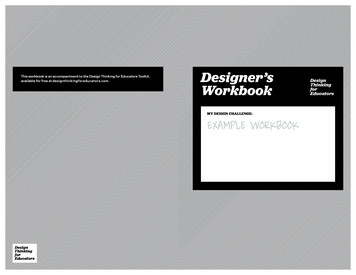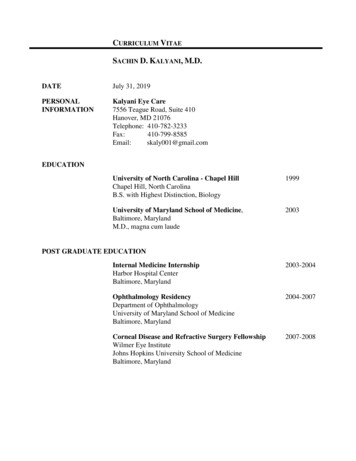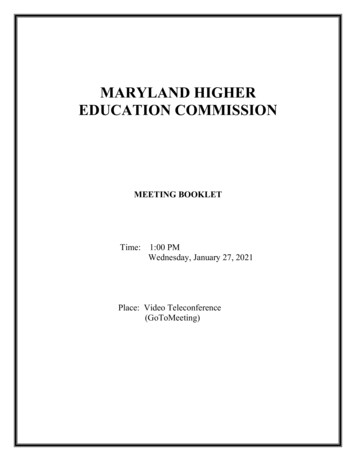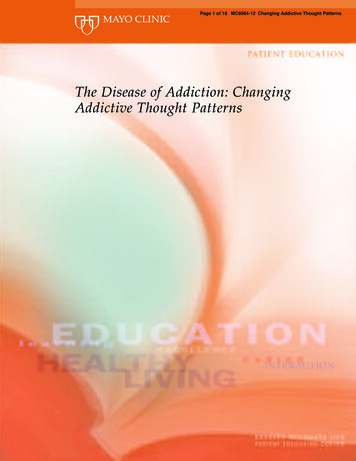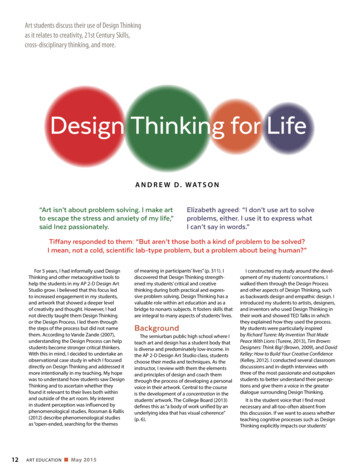
Transcription
Art students discuss their use of Design Thinkingas it relates to creativity, 21st Century Skills,cross-disciplinary thinking, and more.Design Thinking for LifeA N D R E W D . W AT S O N“Art isn’t about problem solving. I make artto escape the stress and anxiety of my life,”said Inez passionately.Elizabeth agreed: “I don’t use art to solveproblems, either. I use it to express whatI can’t say in words.”Tiffany responded to them: “But aren’t those both a kind of problem to be solved?I mean, not a cold, scientific lab-type problem, but a problem about being human?”For 5 years, I had informally used DesignThinking and other metacognitive tools tohelp the students in my AP 2-D Design ArtStudio grow. I believed that this focus ledto increased engagement in my students,and artwork that showed a deeper levelof creativity and thought. However, I hadnot directly taught them Design Thinkingor the Design Process. I led them throughthe steps of the process but did not namethem. According to Vande Zande (2007),understanding the Design Process can helpstudents become stronger critical thinkers.With this in mind, I decided to undertake anobservational case study in which I focuseddirectly on Design Thinking and addressed itmore intentionally in my teaching. My hopewas to understand how students saw DesignThinking and to ascertain whether theyfound it relevant to their lives both withinand outside of the art room. My interestin student perception was influenced byphenomenological studies. Rossman & Rallis(2012) describe phenomenological studiesas “open-ended, searching for the themes12ART EDUCATIONn May 2015of meaning in participants’ lives” (p. 311). Idiscovered that Design Thinking strengthened my students’ critical and creativethinking during both practical and expressive problem solving. Design Thinking has avaluable role within art education and as abridge to nonarts subjects. It fosters skills thatare integral to many aspects of students’ lives.BackgroundThe semiurban public high school where Iteach art and design has a student body thatis diverse and predominately low-income. Inthe AP 2-D Design Art Studio class, studentschoose their media and techniques. As theinstructor, I review with them the elementsand principles of design and coach themthrough the process of developing a personalvoice in their artwork. Central to the courseis the development of a concentration in thestudents’ artwork. The College Board (2013)defines this as “a body of work unified by anunderlying idea that has visual coherence”(p. 6).I constructed my study around the development of my students’ concentrations. Iwalked them through the Design Processand other aspects of Design Thinking, suchas backwards design and empathic design. Iintroduced my students to artists, designers,and inventors who used Design Thinking intheir work and showed TED Talks in whichthey explained how they used the process.My students were particularly inspiredby Richard Turere: My Invention That MadePeace With Lions (Turere, 2013), Tim Brown:Designers: Think Big! (Brown, 2009), and DavidKelley: How to Build Your Creative Confidence(Kelley, 2012). I conducted several classroomdiscussions and in-depth interviews withthree of the most passionate and outspokenstudents to better understand their perceptions and give them a voice in the greaterdialogue surrounding Design Thinking.It is the student voice that I find mostnecessary and all-too-often absent fromthis discussion. If we want to assess whetherteaching cognitive processes such as DesignThinking explicitly impacts our students’
Figure 1. The STEM Fab Studio Design Process developed by Nick DiGiorgio for FabLab and the Cleveland City Public Schools in 2012.understanding, we need to hear the students’perspectives. We need to understand howthey use these thinking processes in theirlives now and how they plan to use themin the future. If our students do not findrelevance in Design Thinking, teaching it is oflittle value.StudentsTo better understand the observations ofthe three students I interviewed, it is valuableto know a bit about them. Forrest is a Whitemale from a middle-class family. He had previously taken multiple courses with me. Forresthas a deep love of making art, especiallyanimation, and his work had been recognizedin several major competitions. His artworkalmost always showcases his zany sense ofhumor; he has developed a quirky style thatis easily identifiable to anyone with even apassing familiarity with his work. Tiffany isan African American female from a workingclass family. She had little formal training inart before her junior year, but her self-taughtdrawing skills and passion for creating ledme to approve her to skip several courseprerequisites to enter into our most advancedart class. In addition to school, Tiffany workedfull-time at a local grocery market to help herfamily after her father lost his job. While dedicated and responsible, she often had troublefocusing in class due to fatigue. Santiago is aLatino male and a first-generation immigrantto the United States, from a low-incomefamily. Santiago had taken two art courseswith me over the previous years. While heenjoys art, Santiago is primarily interested incomputers and building functional, oftenmechanical objects. These students’ insightsexpanded my thoughts on design and DesignThinking.Design Thinking andProblem SolvingVande Zande (2011) explains that “theword design is both a verb and a noun” (p.28). We make designs, and the cognitiveactivities we use to make them are referredto as Design Thinking (Visser, 2006). Central tothese activities is the Design Process. All threeof the students I interviewed described theDesign Process as a way to solve problems. Infact, both Forrest and Tiffany defined DesignThinking as a method of problem solving.The students all found this form of problemsolving very relevant in their art classes;however, it is not unique to art. Santiagodiscussed how he used the Design Processin his engineering class with some slightchanges to how problems were approached.Tiffany echoed Trilling & Fadel (2009) bydrawing parallels between the Design Processand the scientific experimental method(p. 92).There are dozens of versions of the DesignProcess. With my students, I used the STEMFab Studio Design Process developed by NickDiGiorgio for FabLab and the Cleveland CityPublic Schools in 2012 (Figure 1). The steps ofthis process are Ask, Imagine, Design, Build,Evaluate, Refine, and Share. I will explain thesesteps with the assistance of the voices of mystudents.May 2015 n ART EDUCATION13
ASKSantiago explained that Ask describes thestating of the problem, but that sometimes theproblem is not apparent; rather, the teacher“gives us a concept and constraints so we haveto sort of come up with the problem.” To helpmy students start their artwork, I often gavethem a topic or a one-word prompt to consider.The students indicated that both in art and inlife, sometimes problems are too ambiguous toeasily state. Thus, Ask can be making sense of aproblem. Forrest used Ask to set up the comedicpremise of his artworks. Tiffany discussedmaking artwork for a friend and using Ask tothink about what her friend would appreciatein it. In the artworks pictured here, Forrest isresponding to the prompt Ritual and Tiffanyis responding to the prompt Loss. In addition,the students were constrained by the needto create the piece with Photoshop, a tightschedule, and a need to address narrative intheir piece. Otherwise, this project focused onfacilitating the creation of student-generatedartwork.IMAGINESantiago explained that Imagine describesthe ideation of multiple solutions and mightinvolve research or mind mapping. Tiffany usedImagine to come up with multiple variationsto a solution; sometimes these were variationsin the pose of a drawn figure or central themebehind the narrative arc of a comic strip (Figure2). Forrest thought of Imagine as the primarycreative step of Design Thinking, where he triedout different ideas and added a little twist toadd a surreal element to his work. My studentsoften utilized word webs and mind maps tohelp generate ideas and make connections. Ina later classroom discussion, Forrest indicatedthat he felt the making of unexpected connections through his mind maps was an importantcomponent to developing the humor in hiswork (Figure 3).TOP:Figure 2. Imagine—Tiffany’s word web for the prompt Loss.LEFT:Figure 3. Imagine—Forrest’s word web for the prompt Ritual.14ART EDUCATIONn May 2015
Figure 4. Design—Tiffany’s storyboard for the prompt Loss.DESIGNTiffany explained that Design describesthe step where you use sketches or storyboards to envision your solution (Figure 4).Santiago elaborated that this allows you tomore closely explore your best solutions tothe problem. Forrest related Design to visuallycommunicating the ideas that he generatedin Imagine (Figure 5).BUILDForrest explained that Build describes thestep where you take your ideas and createthe solution by using media or technicalapproaches to making. Santiago describedusing Build in an engineering class asprototyping. I am not sure that this parallelis completely accurate, as prototypes closelyresemble a sculptor’s maquette, which moreclosely aligns with the Design step. Tiffanyoften used her favorite sketch and built it upwith layers of media or scanned it and drewon top of it.EVALUATESantiago explained that Evaluate describesthe step where you initially share yourwork with others, often through a formalFigure 5. Design—Forrest’s sketches for the prompt Ritual.critique. Forrest used Evaluate to make surehe communicated his ideas and could makethe audience laugh. Tiffany used it to seeif her work was improving and moving ininteresting directions. Santiago also pointedout that in art we often use Evaluate beforewe Build our solution. This may relate to hisinsight on prototyping, or it may indicate thatthis particular version of the Design Processdoes not perfectly align with my instruction.REFINEForrest explained that Refine describes thestep where you respond to Evaluate. This iswhere he would tweak the joke if someonedid not laugh. Tiffany used Refine to clean upher artwork and sometimes also to start overand come up with a better idea. This is animportant aspect of the Design Process and isintentionally addressed in this version. As NickDiGiorgio explained, “I really wanted to makeit clear that design is iterative and that youhave to use trial and error to come up with thebest solution. I added the inner circle of thecycle to address this” (personal communication, May 28, 2014).The studentsindicated thatboth in artand in life,sometimesproblems aretoo ambiguousto easily state.May 2015 n ART EDUCATION15
Figure 6. Share—Tiffany’s finishedartwork for theprompt Loss.SHAREDesignThinkinggave him[the student]a way tointentionallywork throughgetting stuck.16ART EDUCATIONn May 2015Santiago explained that Share describes thestep where the finished work is displayed orpresented for others to see, usually as somesort of exhibition. Tiffany disclosed that shesometimes made tee-shirts from her artworkand wears them around town. For her responseto the prompt Loss, Tiffany displayed herfive-page comic, “Scream for Ice Cream.” Inour school, and she hopes to publish it in anupcoming comic anthology (Figure 6). Forrestpointed out that Share is a final version ofEvaluate, after you have decided the work nolonger needs refinement. As an educator, thisbrought to my mind the difference betweenformative and summative assessment(Figure 7).Formalizing the ProcessAlthough they did not use these words,both Tiffany and Forrest claimed that DesignThinking formalizes an informal process thatis already a part of art. Vande Zande (2011)explains, “We all design naturally when wemake decisions about what to wear, how topersonalize our living spaces, or how to fashionour appearance” (p. 27). In Forrest’s words,Design Thinking was always a part of his artexperience, but “before we introduced all of thenames for design thinking, it was a thing youdid in the back of your head.” He elaborated:When you actually learn about the termsand the thinking behind it, you knowmore what to do, and if you get stuckyou can go back to the steps. So, it helpsguide whatever work you are doing tohelp move in the right direction.Tiffany echoed this concept when she said,“In the past, I guess I used it a bit in my otherart classes, but I never had a name for it, andif I had trouble, I didn’t have a way to workthrough it.” Santiago concurred that DesignThinking gave him a way to intentionally workthrough getting stuck. All of my participantsagreed that having this formal or intentionalprocess helped them produce better ideas andkept them going when they got stuck in theproblem-solving process.Tiffany and Santiago both revealed thatformalizing the process allowed them to solvelarger and more complex problems. In the artroom, they agreed that Design Thinking wasmore useful than other activities for projectsthat required original thought. My studentsfound this aspect of Design Thinking evenmore useful outside the art room. Tiffany usedDesign Thinking at work to raise 13,000 fora breast cancer charity. She believed that shewould have given up on the project if she didnot have the Design Process to fall back onwhen she got stuck. Santiago indicated thatDesign Thinking gave him confidence to builda go-kart and other complex projects at home.
Figure 7. Share—Forrest’s finished artworkfor the prompt Ritual.21st Century Skills andCreative IndustriesAll three students made connectionsbetween Design Thinking and creativity.Creativity, an intrinsically holistic trait—and,according to Zimmerman (2009), inclusiveof behavioral aspects such as personalmotivation, emotional reaction, cognitivecomplexity, and technical ability—is nowseen as one of the most important skillsfor business leaders (IBM Global BusinessServices, 2012). Creativity is a cornerstoneof the 21st Century Skills movement, whichseeks to refocus education on the needs ofthe emerging innovation economy. Trillingand Fadel (2009) identified the key learningand innovation skills of the 21st CenturySkills movement as (1) critical thinkingand problem solving, (2) communicationand collaboration, and (3) creativity andinnovation.Throughout my interviews, the participants discussed the relationship betweenDesign Thinking and the 21st Century Skills.Trilling and Fadel noted that “these skills arethe keys to unlocking a lifetime of learningand creative work” (p. 49). Both problemsolving and creativity were identified bymy students as the core of Design Thinking.Communication was frequently mentioned byForrest, who said, “trying to get a joke acrossor trying to get an idea through the artworkis kind of how I use it [Design Thinking] mostof the time.” Forrest later mentioned theimportance of Design Thinking to collaboration when he said: “Animations are usuallyso big and complex and require so manypeople that you need Design Thinking to geteveryone going in the same direction to get itall done.” Santiago echoed this sentiment: “IfI’m designing an engine, or a computer chip,or robot, whatever, I’ll be working with a teamfiguring out how to solve problems with technology.” The relevance of Design Thinking tothe 21st Century Skills movement was recognized by Trilling and Fadel when they claimedthat “learning to design and designing tolearn will prepare students for the demandsof the Innovation Age” (p. 107).Authors such as Pink (2005), Florida (2002),and Gardner (2006), as well as businessleaders including Robert Lutz and the lateSteve Jobs, saw creative thinking as one ofthe key skills for the 21st-century economy.The United Kingdom’s Department of Culture,Media, and Sport (2001) defined theseemerging creative industries as ones “whichhave their origin in individual creativity, skilland talent and which have a potential forwealth and job creation through the generation and exploitation of intellectual property”(p. 4). It is difficult to measure the impact ofthe creative industries, but the Departmentof Culture, Media, and Sport estimated that in2000 they accounted for over 1 million jobsand 112.5 billion in earnings for the UnitedKingdom’s economy alone. This figure wouldclearly be much higher in the US, but theBureau of Labor Statistics does not measuredata under creative industries as a distinctcategory. Both Forrest and Tiffany expressedinterest in pursuing a career in the creativeindustries. Forrest was most interested inworking as an animator, but was also interested in film and Web design. Tiffany was lessspecific about her interests, but mentionedmarketing and communications. Bothstudents saw Design Thinking as critical fortheir chosen fields.Cross-DisciplinaryDesign ThinkingWhile my students understood DesignThinking as a process for general problemsolving, they also saw it as an important partof art specifically and as nurturing to creativethinking intrinsically. Seidel, Trishman, Winner,Hetland, and Palmer (2009) claimed that oneof the primary purposes of art education isthe fostering of broad dispositions, includingcreative thinking and making connections.When looking at the transfer of learning fromart education to other subjects, Hetland andWinner (2004) advocated for educators toMay 2015 n ART EDUCATION17
focus on the bridges between the disciplines,such as critical thinking and creativity. Whenwe compare the themes of Design Thinkingto the purposes of art education and thebridges between art education and the otherdisciplines, it becomes apparent that DesignThinking has an important role within arteducation and may have an even greaterrole in connecting art education to a largerintegrated curriculum.Trilling and Fadel (2009) explained thatthe integration of art and design into STEMto create STEAM should be an importantgoal of education for the coming innovation economy. This—combined with Bullittand Bullitt’s (2012) suggestion that DesignThinking’s unique relationship with engineering and the sciences could supportfurther integration between science and theArts—suggests that Design Thinking hasan important role as a bridge within STEAMeducation. However, we must remember thatart education has key aspects and purposesthat are not shared with Design Thinking,and that neither Design Thinking nor STEAMeducation should replace art education. Wecannot ignore Hetland and Winner’s (2004)warning that “arts programs should never bejustified primarily on what the arts can do forother subjects” (p. 136).ConclusionI have noticed an obvious unease whenI talk with some progressive art educators about Design Thinking. I believe thatthey, understandably, worry that a focuson design will take art education back toits 19th-century roots of the MassachusettsDrawing Act and to serving industry byteaching manual skills. I hear their fearsreflected in the voices of my students Inezand Elizabeth, who were at first uncomfortable thinking of art as problem solving.However, when I listen to the rest of mystudents, I do not hear them speaking aboutDesign Thinking only for their future careersor to solve problems. I hear them talkingabout using Design Thinking to make senseof ambiguity, to empathize with others, tothink creatively, to communicate ideas, tocollaborate, and to make people laugh. Indescribing the goals of holistic art educators,London (2004) wrote: “Our ultimate ambitionis to elevate behavior to the degree thatthe whole and integrated person appearsthe necessary precursor of the whole andintegrated society” (p. 2). Today, the needs ofindustry closely align with the goals of holisticart education. Tomorrow, our creative andintegrated students may change industry andits role in society.Andrew Watson is an Art Teacher forFairfax County Public Schools in FallsChurch, Virginia; and a Founding Memberof the Board Of Directors, The InnovationCollaborative, Washington, DC. E-mail:ADWatson@fcps.eduAUTHOR NOTESAll images used with permission.The research for this article was conducted as part ofthe author's Master of Arts in Art Education degreefrom the Maryland Institute College of Art (MICA).Thanks are extended to MAAE faculty who facilitatedthe design, implementation, and reporting of thisresearch.REFERENCESBrown, T. (2009). Tim Brown:Designers—think big! [Video file].Retrieved from www.ted.com/talks/tim brown urges designers tothink big?language enBullitt, J., & Bullitt, M. (2012). A placefor ART and DESIGN educationin the STEM conversation. ArtEducation, 65(2), 40-47.College Board, The. (2013). AP StudioArt 2013 scoring guidelines. NewYork, NY.Department of Culture, Media, andSport. (2001). Creative IndustriesMapping Document (2nd ed.).London, England: Author.FabLab. (2012). The STEM Fab Studiodesign process. [N. DiGiorgio,Instructor]. Cleveland, OH.Florida, R. (2002). The rise ofthe creative class, and how it’stransforming work, leisure,community, and everyday life. NewYork, NY: Basic Books.Gardner, H. (2006). Five minds forthe future. Boston, MA: HarvardBusiness School Press.18ART EDUCATIONn May 2015Hetland, L., & Winner, E. (2004).Education to nonarts outcomes:Research evidence and policyimplications. In E. Eisner and M.Day (Eds.), Handbook of research andpolicy in arts education (pp. 135-161).Mahwah, NJ: Routledge.IBM Global Business Service. (2012).Leading through connections:Highlights of the Global ChiefExecutive Officer Study. Somers, NY:Author.Kelley, D. (2012). David Kelley: Howto build your creative confidence.[Video file]. Retrieved from www.ted.com/talks/david kelleyhow to build your creativeconfidence?language enLondon, P. (2004). Holistic theoryin art education. In P. Londonand The Study Group for HolisticArt Education, Toward a holisticparadigm in art education (pp.1-5). Baltimore: Maryland InstituteCollege of Art.Pink, D. H. (2005). A whole new mind:Moving from the information age tothe conceptual age. New York, NY:Penguin.Rossman, G. B., & Rallis, S. F. (2012).Learning in the field: An introductionto qualitative research (3rd ed.).Thousand Oaks, CA: Sage.Seidel, S., Trishman, S., Winner,E., Hetland, L., & Palmer, P.(2009). The qualities of qualities:Understanding excellence in artseducation. Cambridge, MA: ProjectZero, Harvard Graduate School ofEducation.Trilling, B., & Fadel, C. (2009). 21stcentury skills: Learning for lifein our times. San Francisco, CA:Jossey-Bass.Turere, R. (2013). Richard Turere: Myinvention that made peace with lions.[Video file]. Retrieved from www.ted.com/talks/richard turere a peacetreaty with the lions?language en.Vande Zande, R. (2007). Designeducation as community outreachand interdisciplinary study. LearningThrough the Arts Journal, 3(1).Retrieved from nde Zande, R. (2011). Designeducation supports socialresponsibility and the economy. ArtsEducation Policy Review, 112(1),26-34.Visser, W. (2006). The cognitive artifactsof designing. Mahwah, NJ:L. Erlbaum.Zimmerman, E. (2009).Reconceptualizing the role ofcreativity in art education theory andpractice. Studies in Art Education,50(4), 382-399.
dialogue surrounding Design Thinking. It is the student voice that I find most necessary and all-too-often absent from this discussion. If we want to assess whether teaching cognitive processes such as Design Thinking explicitly impacts our students’ ANDREW D. WATSON Design Thinking for Life “Art isn’t about problem solving. I make art to .




